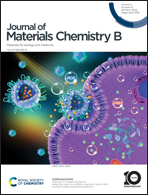Poly(succinimide) nanoparticles as reservoirs for spontaneous and sustained synthesis of poly(aspartic acid) under physiological conditions: potential for vascular calcification therapy and oral drug delivery†
Abstract
This paper describes the preparation of poly(succinimide) nanoparticles (PSI NPs) and investigates their properties and characteristics. Employing direct and inverse precipitation methods, stable PSI NPs with tunable size and narrow dispersity were prepared without the use of any stabilizer or emulsifier. It was demonstrated that PSI NPs convert to poly(aspartic acid) (PASP) gradually under physiological conditions (37 °C, pH 7.4), while remaining stable under mildly acidic conditions. The dissolution profile was tuned and delayed by chemical modification of PSI. Through grafting a fluorophore to the PSI backbone, it was also demonstrated that such a spontaneous conversion could offer great potential for oral delivery of therapeutic agents to the colon. Sustained PASP synthesis also contributed to a sustained reduction of reactive oxygen species induced by iron. Furthermore, PSI NPs effectively prevented in vitro calcification of smooth muscle cells. This was attributed to the chelation of calcium ions to PASP, thereby inhibiting calcium deposition, because under cell culture conditions PSI NPs serve as reservoirs for the sustained synthesis of PASP. Overall, this study sheds light on the preparation and features of biocompatible and biodegradable PSI-based NPs and paves the way for further research to discover as-yet unfulfilled potential of this polymer in the form of nanoparticles.



 Please wait while we load your content...
Please wait while we load your content...